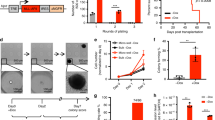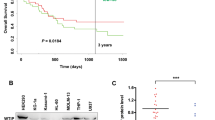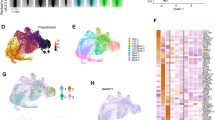Abstract
Acute lymphoblastic leukemia (ALLs) expressing MLL-AF4, the fusion product of t(4;11)(q21;q23), show marked leucocytosis and extramedullary disease in multiple organs, respond poorly to chemotherapy and have poor prognosis. In vitro, leukemic cells with the t(4;11) show resistance to serum deprivation-induced or interferon γ-regulated CD95-mediated apoptosis. In addition, t(4;11) cells have prolonged doubling time and lower percentage of cells in cycle compared to non-t(4;11) B lineage cell lines. In this study, we examine the time- and level-dependent effects of MLL-AF4 conditional expression on cell cycle and differentiation of myelomonocytic leukemia cell line U937. By varying the concentration of tetracycline in growth media, we found that increasing levels of MLL-AF4 expression result in a progressive decrease in growth rate and fraction of S phase cells, paralleled by an increase in percentage of cells expressing CD11b. Our results demonstrate a dosage-dependent effect of MLL-AF4 fusion oncoprotein on cell cycle progression, with increasing expression levels resulting in the accumulation in G1, prolonged doubling time, both findings that might be responsible for the increased resistance to etoposide-mediated cytotoxicity. We propose the cell cycle control exerted by MLL-AF4 may be responsible of resistance to cell-death promoting stimuli in leukemia carrying the t(4;11) translocation.
This is a preview of subscription content, access via your institution
Access options
Subscribe to this journal
Receive 12 print issues and online access
$259.00 per year
only $21.58 per issue
Buy this article
- Purchase on Springer Link
- Instant access to full article PDF
Prices may be subject to local taxes which are calculated during checkout





Similar content being viewed by others
References
Ziemin-van der Poel S, McCabe NR, Gill HJ, Espinosa III R, Patel Y, Harden A et al. Identification of a gene, MLL, that spans the breakpoint in 11q23 translocations associated with human leukemias. Proc Natl Acad Sci USA 1991; 88: 10735–10739.
Thirman MJ, Gill HJ, Burnett RC, Mbangkollo D, McCabe NR, Kobayashi H et al. Rearrangement of the MLL gene in acute lymphoblastic and acute myeloid leukemias with 11q23 chromosomal translocations. N Engl J Med 1993; 329: 909–914.
Gu Y, Alder H, Nakamura T, Schichman SA, Prasad R, Canaani O et al. Sequence analysis of the breakpoint cluster region in the ALL-1 gene involved in acute leukemia. Cancer Res 1994; 54: 2326–2330.
Dimartino JF, Cleary ML . Mll rearrangements in haematological malignancies: lessons from clinical and biological studies. Br J Haematol 1999; 106: 614–626.
Nakamura T, Mori T, Tada S, Krajewski W, Rozovskaia T, Wassell R et al. ALL-1 is a histone methyltransferase that assembles a supercomplex of proteins involved in transcriptional regulation. Mol Cell 2002; 10: 1119–1128.
Yokoyama A, Kitabayashi I, Ayton PM, Cleary ML, Ohki M . Leukemia proto-oncoprotein MLL is proteolytically processed into 2 fragments with opposite transcriptional properties. Blood 2002; 100: 3710–3718.
Hsieh JJ, Ernst P, Erdjument-Bromage H, Tempst P, Korsmeyer SJ . Proteolytic cleavage of MLL generates a complex of N- and C-terminal fragments that confers protein stability and subnuclear localization. Mol Cell Biol 2003; 23: 186–194.
Dobson CL, Warren AJ, Pannell R, Forster A, Rabbitts TH . Tumorigenesis in mice with a fusion of the leukaemia oncogene Mll and the bacterial lacZ gene. EMBO J 2000; 19: 843–851.
Joh T, Yamamoto K, Kagami Y, Kakuda H, Sato T, Yamamoto T et al. Chimeric MLL products with a Ras binding cytoplasmic protein AF6 involved in t(6;11) (q27;q23) leukemia localize in the nucleus. Oncogene 1997; 15: 1681–1687.
Butler LH, Slany R, Cui X, Cleary ML, Mason DY . The HRX proto-oncogene product is widely expressed in human tissues and localizes to nuclear structures. Blood 1997; 89: 3361–3370.
Yano T, Nakamura T, Blechman J, Sorio C, Dang CV, Geiger B et al. Nuclear punctate distribution of ALL-1 is conferred by distinct elements at the N terminus of the protein. Proc Natl Acad Sci USA 1997; 94: 7286–7291.
Ennas MG, Sorio C, Greim R, Nieddu M, Scarpa A, Orlandini S et al. The human ALL-1/MLL/HRX antigen is predominantly localized in the nucleus of resting and proliferating peripheral blood mononuclear cells. Cancer Res 1997; 57: 2035–2041.
Caslini C, Serna Alarcon A, Hess JL, Tanaka R, Murti KG, Biondi A . The amino terminus targets the mixed lineage leukemia (MLL) protein to the nucleolus, nuclear matrix and mitotic chromosomal scaffolds. Leukemia 2000; 14: 1898–1908.
Ayton PM, Cleary ML . Molecular mechanisms of leukemogenesis mediated by MLL fusion proteins. Oncogene 2001; 20: 5695–5707.
Gu Y, Nakamura T, Alder H, Prasad R, Canaani O, Cimino G et al. The t(4;11) chromosome translocation of human acute leukemias fuses the ALL-1 gene, related to Drosophila trithorax, to the AF-4 gene. Cell 1992; 71: 701–708.
Domer PH, Fakharzadeh SS, Chen CS, Jockel J, Johansen L, Silverman GA et al. Acute mixed-lineage leukemia t(4;11)(q21;q23) generates an MLL-AF4 fusion product. Proc Natl Acad Sci USA 1993; 90: 7884–7888.
Morrissey J, Tkachuk DC, Milatovich A, Francke U, Link M, Cleary ML . A serine/proline-rich protein is fused to HRX in t(4;11) acute leukemias. Blood 1993; 81: 1124–1131.
Nakamura T, Alder H, Gu Y, Prasad R, Canaani O, Kamada N et al. Genes on chromosomes 4, 9, and 19 involved in 11q23 abnormalities in acute leukemia share sequence homology and/or common motifs. Proc Natl Acad Sci USA 1993; 90: 4631–4635.
Biondi A, Rambaldi A, Rossi V, Elia L, Caslini C, Basso G et al. Detection of ALL-1/AF4 fusion transcript by reverse transcription-polymerase chain reaction for diagnosis and monitoring of acute leukemias with the t(4;11) translocation. Blood 1993; 82: 2943–2947.
Biondi A, Cimino G, Pieters R, Pui CH . Biological and therapeutic aspects of infant leukemia. Blood 2000; 96: 24–33.
Caslini C, Shilatifard A, Yang L, Hess JL . The amino terminus of the mixed lineage leukemia protein (MLL) promotes cell cycle arrest and monocytic differentiation. Proc Natl Acad Sci USA 2000; 97: 2797–2802.
Gossen M, Bujard H . Tight control of gene expression in mammalian cells by tetracycline-responsive promoters. Proc Natl Acad Sci USA 1992; 89: 5547–5551.
Vignali DA, Carson RT, Chang B, Mittler RS, Strominger JL . The two membrane proximal domains of CD4 interact with the T cell receptor. J Exp Med 1996; 183: 2097–2107.
Boer J, Bonten-Surtel J, Grosveld G . Overexpression of the nucleoporin CAN/NUP214 induces growth arrest, nucleocytoplasmic transport defects, and apoptosis. Mol Cell Biol 1998; 18: 1236–1247.
Shockett P, Difilippantonio M, Hellman N, Schatz DG . A modified tetracycline-regulated system provides autoregulatory, inducible gene expression in cultured cells and transgenic mice. Proc Natl Acad Sci USA 1995; 92: 6522–6526.
Li Q, Frestedt JL, Kersey JH . AF4 encodes a ubiquitous protein that in both native and MLL-AF4 fusion types localizes to subnuclear compartments. Blood 1998; 92: 3841–3847.
van Dongen JJ, Macintyre EA, Gabert JA, Delabesse E, Rossi V, Saglio G et al. Standardized RT-PCR analysis of fusion gene transcripts from chromosome aberrations in acute leukemia for detection of minimal residual disease. Report of the BIOMED-1 Concerted Action: investigation of minimal residual disease in acute leukemia. Leukemia 1999; 13: 1901–1928.
Gabert J, Beillard E, van der Velden VH, Bi W, Grimwade D, Pallisgaard N et al. Standardization and quality control studies of ‘real-time’ quantitative reverse transcriptase polymerase chain reaction of fusion gene transcripts for residual disease detection in leukemia – a Europe Against Cancer program. Leukemia 2003; 17: 2318–2357.
Yin DX, Zhu L, Schimke RT . Tetracycline-controlled gene expression system achieves high-level and quantitative control of gene expression. Anal Biochem 1996; 235: 195–201.
Kringstein AM, Rossi FM, Hofmann A, Blau HM . Graded transcriptional response to different concentrations of a single transactivator. Proc Natl Acad Sci USA 1998; 95: 13670–13675.
Huang CJ, Spinella F, Nazarian R, Lee MM, Dopp JM, de Vellis J . Expression of green fluorescent protein in oligodendrocytes in a time- and level-controllable fashion with a tetracycline-regulated system. Mol Med 1999; 5: 129–137.
Pui CH, Frankel LS, Carroll AJ, Raimondi SC, Shuster JJ, Head DR et al. Clinical characteristics and treatment outcome of childhood acute lymphoblastic leukemia with the t(4;11)(q21;q23): a collaborative study of 40 cases. Blood 1991; 77: 440–447.
Heerema NA, Sather HN, Ge J, Arthur DC, Hilden JM, Trigg ME et al. Cytogenetic studies of infant acute lymphoblastic leukemia: poor prognosis of infants with t(4;11) – a report of the Children's Cancer Group. Leukemia 1999; 13: 679–686.
Kersey JH, Wang D, Oberto M . Resistance of t(4;11) (MLL-AF4 fusion gene) leukemias to stress-induced cell death: possible mechanism for extensive extramedullary accumulation of cells and poor prognosis. Leukemia 1998; 12: 1561–1564.
Dorrie J, Schuh W, Keil A, Bongards E, Greil J, Fey GH et al. Regulation of CD95 expression and CD95-mediated cell death by interferon-gamma in acute lymphoblastic leukemia with chromosomal translocation t(4;11). Leukemia 1999; 13: 1539–1547.
Ferrando AA, Armstrong SA, Neuberg DS, Sallan SE, Silverman LB, Korsmeyer SJ et al. Gene expression signatures in MLL-rearranged T-lineage and B-precursor acute leukemias: dominance of HOX dysregulation. Blood 2003; 102: 262–268.
Hartwell LH, Kastan MB . Cell cycle control and cancer. Science 1994; 266: 1821–1828.
Del Bino G, Li X, Traganos F, Darzynkiewicz Z . Altered susceptibility of differentiating HL-60 cells to apoptosis induced by antitumor drugs. Leukemia 1994; 8: 281–288.
Ketley NJ, Allen PD, Kelsey SM, Newland AC . Modulation of idarubicin-induced apoptosis in human acute myeloid leukemia blasts by all-trans retinoic acid, 1,25(OH)2 vitamin D3, and granulocyte–macrophage colony-stimulating factor. Blood 1997; 90: 4578–4587.
Ketley NJ, Allen PD, Kelsey SM, Newland AC . Mechanisms of resistance to apoptosis in human AML blasts: the role of differentiation-induced perturbations of cell-cycle checkpoints. Leukemia 2000; 14: 620–628.
Sullivan DM, Glisson BS, Hodges PK, Smallwood-Kentro S, Ross WE . Proliferation dependence of topoisomerase II mediated drug action. Biochemistry 1986; 25: 2248–2256.
Chow KC, Ross WE . Topoisomerase-specific drug sensitivity in relation to cell cycle progression. Mol Cell Biol 1987; 7: 3119–3123.
Dobson CL, Warren AJ, Pannell R, Forster A, Lavenir I, Corral J, Smith AJ, Rabbitts TH . The mll-AF9 gene fusion in mice controls myeloproliferation and specifies acute myeloid leukaemogenesis. EMBO J 1999; 18: 3564–3574.
Acknowledgements
We are very grateful to Dominique Broccoli for helpful discussion. We thank Gerard Grosveld for U937T cell line, John H Kersey for α-AF4 C15 polyclonal antibodies, Xiangxi Xu and Maureen Murphy for sharing reagents. Supported by Fondazione ‘M. Tettamanti’, Associazione Italiana Ricerca sul Cancro (AIRC) and Ministero Istruzione Università e Ricerca (MIUR).
Author information
Authors and Affiliations
Rights and permissions
About this article
Cite this article
Caslini, C., Serna, A., Rossi, V. et al. Modulation of cell cycle by graded expression of MLL-AF4 fusion oncoprotein. Leukemia 18, 1064–1071 (2004). https://doi.org/10.1038/sj.leu.2403321
Received:
Accepted:
Published:
Issue Date:
DOI: https://doi.org/10.1038/sj.leu.2403321
Keywords
This article is cited by
-
The oncogenic fusion protein CBFB-SMMHC downregulates CD48 to evade NK cell recognition
Blood Cancer Journal (2018)
-
Combined effects of the two reciprocal t(4;11) fusion proteins MLL·AF4 and AF4·MLL confer resistance to apoptosis, cell cycling capacity and growth transformation
Oncogene (2007)
-
Immunobiological diversity in infant acute lymphoblastic leukemia is related to the occurrence and type of MLL gene rearrangement
Leukemia (2007)



